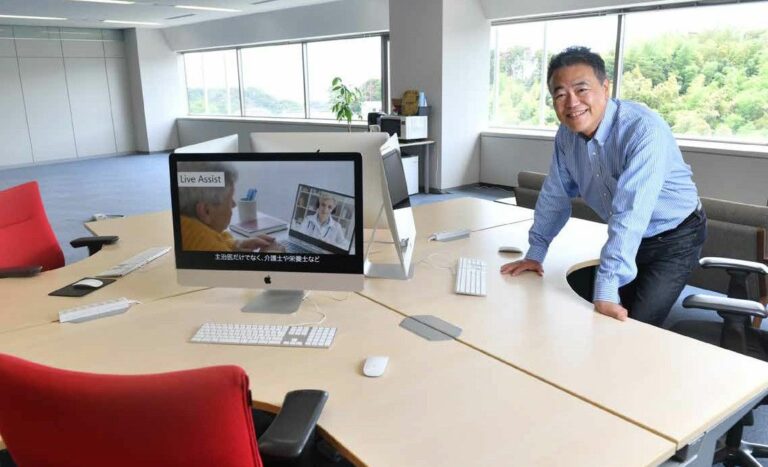Today, call centers handle not only phone calls but also chat, social media, and other ways of communicating. Behind the scenes, the world’s most advanced systems and software are in use, and Communication Business Avenue (CBA) has been a leader in bringing these technologies to Japan. The company offers a variety of solutions, including products they developed themselves, to major e-commerce sites and BPO (Business Process Outsourcing) companies like Bellsystem24. We interviewed CEO Hiroshi Shibayama, who has built relationships with some of the world’s top venture companies, even though he lacks the funds and technology to do so.


Head office: 3-4 Hikarigaoka, Yokosuka City,Kanagawa PrefectureYRP (Yokosuka Research Park) Center 1, 5F
Established: 2006
Capital: 40.16 million yen
Sales: 940 million yen (FY2020)
Employees: 120
Call centers, which we have all experienced at some point, continue to evolve. They used to be mainly focused on phone calls, but now they support chat, messaging, LINE, Facebook, and other social media platforms. Additionally, there is a system where operators can share the customer’s browser screen and teach them how to use the products.
Communication Business Avenue (CBA), headquartered in Yokosuka, Japan, was one of the first companies in the world to introduce these new technologies to Japan by translating and customizing them for its customers. “We have worked hard to make cutting-edge software and systems, mainly developed by American companies, available in Japan,” says Hiroshi Shibayama, the company’s CEO.
CBA mainly provides solutions to call centers for major e-commerce sites and works with major BPO (Business Process Outsourcing) companies like Bellsystem24 and Prestige International, which handle call center operations for them. CBA is currently doing very well, with sales expected to grow from 940 million yen last year to about 1.5 billion yen this year. CEO Shibayama noted, “The Covid-19 situation has led to the opening of many call centers, but even before that, the shift to omnichannel services was already in progress. We believe demand will continue to increase in the future, especially with more connections to AI.”
Omnichannel, as mentioned earlier, means supporting multiple ways to contact a company, such as chat and social media. Simply adding more channels creates more work for operators and makes it harder for them to analyze customer feedback. Therefore, it is necessary to integrate interfaces and data. The solution for this is a cloud-based contact center software called BRIGHT PATTERN.
Another product driving the company’s success is Live Assist. This product uses WebRTC (real-time communication) technology, allowing operators to share their browser screen with customers. This helps them respond via video chat, draw diagrams, assist with input, and send documents. Customers don’t need to download any apps, and anyone can use the system. Not only call centers, but also department stores wanting to stand out from regular e-commerce sites are now actively adopting this system.
With BRIGHT PATTERN and Live Assist as its main focuses, CBA also offers VBVoice, a tool for advanced IVR (automated voice response) functions, a non-contact MR (mixed reality) support tool that lets users point and draw on the screen in real time, a cloud platform for personal authentication, and an AI-powered inquiry management system.
These products are created by CBA’s overseas partners, but CBA also develops and sells visual IVR, simultaneous notification systems via phone and email, automatic reminder systems, and questionnaire systems with automated voices. “We receive a variety of information from our overseas partners, which helps us expand our product lineup. We don’t focus on one specific area because we don’t know where the next opportunity will come from,” says CEO Shibayama.
The company’s strength is that it doesn’t end with just selling its products. In many cases, the products are built on cloud services as applications for end-users’ smartphones and other devices, so once a deal is made, it continues as a contractual relationship. The revenue structure includes the initial cost of introducing the solution and annual license fees, with license fees making up about 70% of sales.
Live Assist was developed by New York-based CafeX Communications, which CBA has partnered with and has been the Japanese distributor for since 2014. However, in 2019, to strategically narrow its product offerings, CafeX transferred the Live Assist business to CBA. In 2020, they also transferred Live Assist for Dynamics 365, which runs on Microsoft’s Dynamics 365 platform for CRM (customer relationship management) and ERP (enterprise resource planning), to CBA. Live Assist is for on-premise (own servers), and Live Assist for Dynamics 365 is a cloud service.
“The amount of the transfer was quite significant for us, but the CEO of CafeX was very supportive and agreed to outsource work equivalent to the transfer amount to us. We received it back over the course of a year, making the transfer almost free of charge,” said CEO Shibayama. This reflects how much CafeX trusted CBA to promote Live Assist effectively.
As a result, CBA has taken over the customers using Live Assist and is now working with global companies like Wells Fargo, Ford Motor Company, Hewlett-Packard, American Express, and others. CBA has also signed contracts with partners to continue supporting these international customers while maintaining its own engineering staff around the world. All employees work from home and have established a strong remote work system, including those in Japan.
Currently, of the 120 employees, 40 are non-Japanese and 80 are Japanese. There are 10 engineers in the US, 7 in the UK, 15 in the Philippines, and about 3 in India. “From the start, the only way to attract talented engineers was to have them work from home. No one would come to Yokosuka. The same goes for overseas staff. Engineers in the Philippines are excellent. They all have university degrees, good English skills, and strong engineering abilities, so they support our US and UK operations. All our employees come to us by word of mouth. We don’t recruit publicly. They invite their skilled personal connections, so our employees are very close to each other.”
CEO Shibayama originally worked as a software developer in the IT department of a publishing company, but he and his colleague Yoichiro Okamura (now CIO = Chief Information Officer) decided to start their own company and founded CBA in 2006. “We couldn’t do what we wanted if we were just another cog in the machine. Rather than subcontracting systems, we wanted to create a company that could provide our own services. We drew up a business plan and first obtained venture certification from Yokosuka City. We didn’t have any money, and we thought we could manage if we passed the certification,” CEO Shibayama says with a wry smile.
The business plan at the time was a POS (point-of-sale) system linked to CRM. He was considering an Internet-based ASP, or what is now called a cloud service. “We thought we could compete because it could be used in various industries,” he recalls, scratching his head.
Although the system was successfully certified, neither CEO Shibayama nor Mr. Okamura knew how to market it. So, they started developing a system for golf courses since Mr. Okamura had a friend who owned one. They worked on-site for several months to create a system that allowed reservations through the website and used barcodes for check-ins and restaurant payments.
To sell this system, they called golf courses and made repeated sales attempts. However, the Internet environment wasn’t established yet, so they had to start by installing a line. Eventually, they received orders from four locations, but the monthly sales were only 200,000 yen because the service had a fixed monthly fee of 50,000 yen. They had no choice but to start localizing software products developed overseas for the Japanese market. They translated the interface and manuals into Japanese, allowing them to sell the products in-house and avoid becoming a subcontractor.
During this process, a Canadian company asked them to localize and sell their IVR (automated voice response) software in Japan. It is VBVoice, which they still sell today. As sales gradually increased, a customer asked them to propose a call center platform that could use this product. At that time, IP-PBX (Premise Based Switching System, which connects company extensions to public lines) was finally gaining popularity, and the customer wanted to switch to IP-PBX. “I had very little knowledge at the time, so I looked online to see what was happening in the U.S. and found a few companies that made IP-PBX-based call center software.”
Then he discovered a product called trixboxPro made by a company called Fonality. When he reached out, they invited him to the U.S. CEO Shibayama and Mr. Okamura went to the U.S. with only about 500,000 yen in their account, thinking, “If we fail, this will be the end of the company.”
They had to undergo technical training and score 90 or higher on the test to qualify to handle the product. Mr. Okamura took the training, while CEO Shibayama negotiated multiple times with Chris Villaume, SVP Sales & Business Development. “He asked, ‘How do you sell in Japan?’ I told him I wanted to sell to call centers, but he didn’t understand and told me to come back. In the U.S., he was selling trixbox to small and medium-sized businesses. I kept explaining, and finally he said, ‘Let’s give it a try.’ I think he was showing me mercy. He called me every day after I returned to Japan. Looking back, he trained me. Mr. Villaume is strict but caring. We still maintain our relationship.”
Thus, CBA entered the call center market through trixboxPro. They still offer this product today, but it is gradually being replaced by BRIGHT PATTERN.
CEO Shibayama aimed to compete with major players and made a sales pitch to Rakuten, the company behind Rakuten Ichiba. After a year of weekly visits, he finally got a chance to demonstrate to CEO Hiroshi Mikitani in 2010 and received approval. At that time, Mr. Villaume accompanied him, supported him, and made arrangements regarding the license price and other matters for CEO Shibayama.
However, what followed was challenging. On-site operators kept asking for new functions, focusing on improving the usability of the existing platform. CEO Shibayama spent a week on-site with his team to develop additional features. The functions they added during that time were successful and helped boost sales afterward. A well-known consulting firm for call centers came in to assist with sales, and trixboxPro began to spread.
In the U.S., new technologies like omnichannel and WebRTC became popular, and CEO Shibayama returned to the U.S. During that visit, he discovered CafeX, the developer of Live Assist. Since CafeX had already gained attention in the U.S., CEO Shibayama thought they wouldn’t partner with an unknown Japanese company, but surprisingly, they signed an exclusive distributor agreement with CBA. “They never asked me about the size of the company or the number of customers. They wanted to know what I aimed to do and why. When I explained, they said, ‘Well, let’s do it.’ This is the great thing about the U.S.—we aren’t bound by past achievements,” says CEO Shibayama.
BRIGHT PATTERN, the company’s current major product, was also developed in partnership with an American company in anticipation of the omni-channel era. “When looking for a long-term partner, good chemistry is crucial. Of course, the quality of the product matters, but if the key person, like the manager, is only focused on numbers, it won’t work well. Developing the Japanese market requires persistence. If you have a partner willing to ‘work together to sell,’ you will succeed.”
We often hear of cases where packaged products from overseas fail to take root in Japan. Localization can only happen when, like CBA, the developer and the product are genuinely integrated into the Japanese language.


